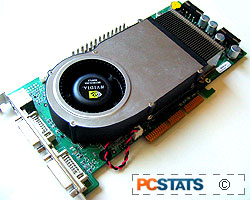DirectX
9.0b-compatible Graphics make Far Cry a true test of DX9 compatible videocards.
Based on the CryENGINE, Far Cry boasts real-time editing, bump mapping, static
lights, network system, integrated physics system, shaders, shadows, and a
dynamic music system. In the absence of either DOOM III or Half-Life 2, Far Cry
has quickly become a single-player hit. Not only does it feature immersive
graphics, but its story is actually somewhat entertaining.
Despite a
recent patch that supposedly accelerated nVidia's shader routines, ATI's new
X800 XT dominates the overall performance picture, though at 1024x768 the
Geforce 6800 Ultra comes in on top. At 1024x768 and 1280x1024, processor
performance looks like it's limiting the X800 XT, while the GeForce 6800 Ultra
begins dropping off after 1280x1024. By 1600x1200, the flagship Radeon X800 XT
flagship has a 21 percent lead on the Geforce 6800 Ultra.
Though Far Cry's graphical intensity shrinks the gap
between the GeForce 6800 Ultra and Radeon X800 to just slightly over 1 FPS at
1600x1200, lower resolutions still favor ATI by up to 14 percent. The Radeon
9800 XT fares just as well, beating nVidia's GeForce FX 5950 Ultra at each
resolution, though only slightly.
Conclusions
 nVidia's new GeForce 6800
Ultra is, without question, a massive improvement over the GeForce FX 5950 Ultra
that came before it. And, at least from first glance, it's pretty clear that
this time nVidia has the performance numbers to back it up.
nVidia's new GeForce 6800
Ultra is, without question, a massive improvement over the GeForce FX 5950 Ultra
that came before it. And, at least from first glance, it's pretty clear that
this time nVidia has the performance numbers to back it up.
Nvidia's new architecture
introduces a lot of potential beyond what we saw with NV3x. To begin, it
features a massively parallel 3D pipeline for achieving up to 8x higher pixel
shading (a historic weakness of NV40's predecessor) and up to 2x better vertex
shading performance.
Moreover,
the architecture supports Shader Model 3.0, part of Microsoft's upcoming DirectX
9.0c. Among the improvements there, displacement mapping, vertex texture
fetching, and FP32 shader precision are perhaps the most notable enhancements.
The DX9 subset also introduces longer vertex and pixel shader programs, dynamic
flow control, and geometry instancing as well, though.
But even
more relevant is the nVidia GeForce 6800's position versus ATI's recently
announced Radeon X800 XT, formerly referred to as R420. The Radeon X800 XT does
lack in a few areas - it doesn't support the Shader Model 3.0 specification, and
in turn, it won't do FP32 precision. At the same time, however, it is a bit
faster than the GeForce 6800 Ultra in what could be construed as the most
demanding metrics, consumes a single AGP slot, and it doesn't come with a 480W
power supply recommendation.
In
response to this, nVidia is reportedly readying a limited-edition version of the
GeForce 6800 Ultra bearing an Extreme suffix. Performance considerations aside,
the Extreme version of the nVidia Geforce 6800 will be even more expensive than
the 6800 Ultra, and purportedly sparsely available. The card's relevance in
relation to its competition remains to be seen, but when it is released, we'll
do our best to bring you a review of it, so you can judge for
yourself.
So,
although nVidia has clearly taken strides to improve upon its previous
architecture, and while it holds Shader Model 3.0 and FP32 precision over ATI's
head, the nVidia GeForce 6800 Ultra fell just short of ATI's Radeon X800 XT
video card in most of the benchmarks we've shown you - especially at higher
resolutions with all the eye candy turned on. For luscious gaming, with killer
image quality at the highest resolutions, it's clear that the Geforce FX 5950
Ultra has been significantly surpassed by the new Geforce 6800 Ultra. The differences
between the nVidia Geforce 6800 Ultra and the ATI Radeon X800 XT are closer, but it is apparent that nVidia's NV40 still has some catching up to do!
Find out about this and many other reviews by joining the
Weekly PCstats.com Newsletter today!
Related Articles
Here are
a few other articles that you might enjoy as well...
1. Albatron FX5900XTV Videocard Review
2. Chaintech Apogee AA5700U Videocard Review
3. Asus A9800XT/TVD/256 Radeon 9800XT Videocard Review
4. Gigabyte GV-R96X128D 9600XT Videocard Review
5. Crucial Radeon 9600 Pro Videocard Review
